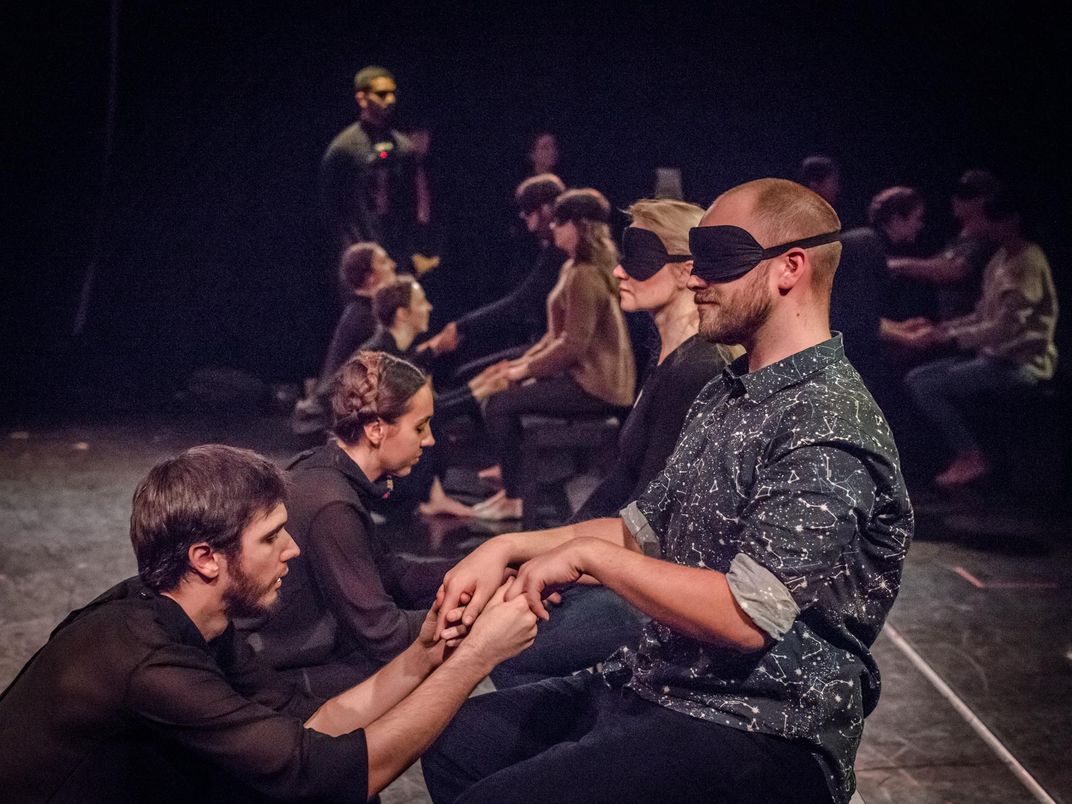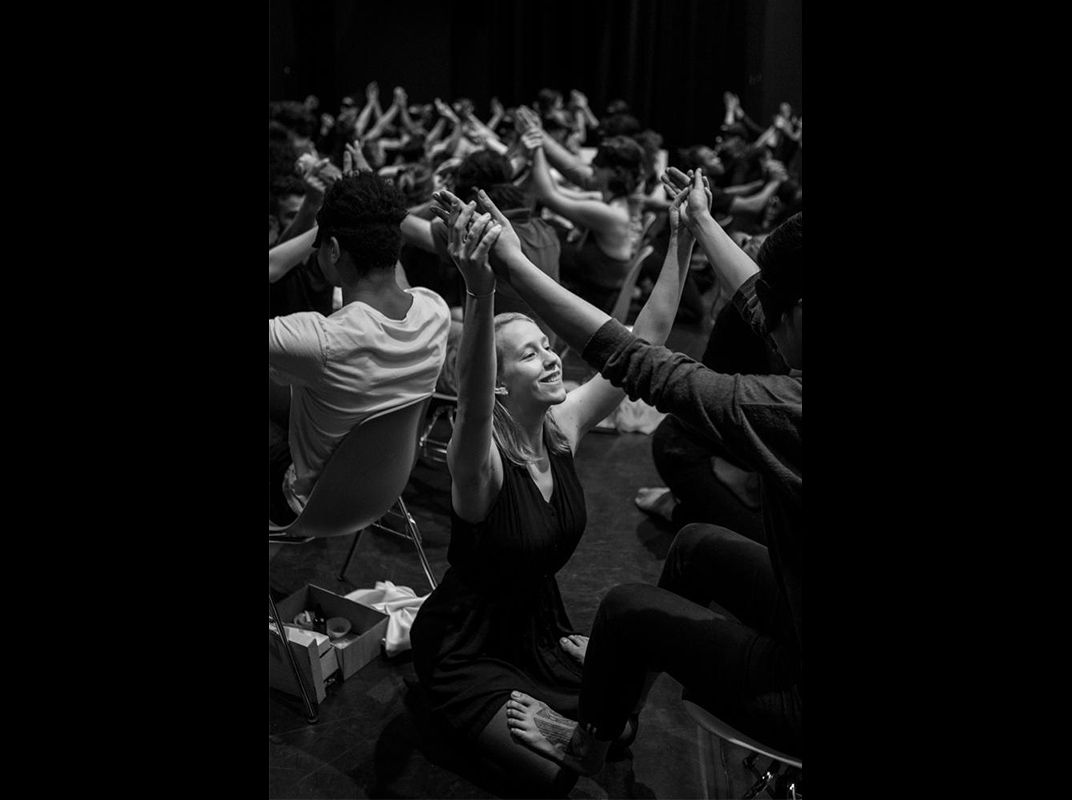Feel the Music—Literally—With Some Help From New Synesthesia Research
How one artist created a show inspired by the neurological experience of synesthesia
/https://tf-cmsv2-smithsonianmag-media.s3.amazonaws.com/filer/53/e5/53e5475f-2e8f-4fec-b296-17ca53f2cd3c/composition-vii-1913.jpg)
On a Friday night in December, I sat in a small room with 33 other audience members, each of us accompanied by a dancer in black. The dancers pulled out blindfolds and covered our eyes, and for a brief moment, all was dark and quiet and freighted with anticipation. Then, as a chamber ensemble began to play Claude Debussy’s String Quartet in G minor, the dancers began to “play” the music on our bodies.
When the music soared, the dancers lifted our feet to mimic the sense of weightlessness. When the music was playful, they tickled our forearms. And when it pressed in intensely, the dancers squeezed our shoulders and rocked our heads.
At times, they held scents near our noses, and wafted a wind across us, and even pressed evocative morsels of food into our mouths—truffle cheese with pop rocks, fizzing as the music rose—as if our entire bodies could be recruited into feeling the mad sensuality of Debussy’s work. As if the idea was to bring us inside the music itself.
When we write about music, we often borrow from the realms of the other senses. High passages are said to “soar”; sad music is “blue.” This was a more literal attempt to help us experience music through multiple senses: music combined with the actual feeling of soaring, the sharpness of high notes, the sourness of discordant ones.
BitterSuite, a British music, dance and experience company, is an effort to open “people up both imaginatively and also bodily,” says its creator, Steph Singer, a 27-year-old British immersive artist and composer. “I want you to not think when you get inside this room. I want you to just feel this music.” Once the curators of this strange affair had eliminated that most dominant sense—sight—audience members were freed up to pay more attention to sound, scent, taste and physical sensation.
Singer’s concept is inspired by synesthesia, the oft-mythologized neurological condition in which people experiencing a crossing over of the senses. For those with synesthesia, who are estimated to number 4 percent of the population or less, “one sensory event leads to an automatic or involuntary experience in some other sensory modality,” says Tony Ro, a professor of psychology and neuroscience at the City University of New York Graduate Center.
Synesthesia is a provocative phenomenon, for both artists and neuroscientists. Some synesthetes say they see colors upon hearing musical notes, or get a taste in their mouths upon saying certain words, or “taste” shapes when they eat, or see black numbers in color. But Singer had a question: Could ordinary people be made to experience the magic, too?

Singer grew up in south east England in a musical family, learning cello from her mom and piano from her aunt. But at school, she found her classical music education dry and rule-bound, more focused on technical perfection than on passion.
While studying music and mixed media arts at University of Sussex, she fell in love with the experimental methods of abstract artist Wassily Kandinsky and composer John Cage, and wondered how playful, full-body approaches to art might allow people to experience it more fully. Kandinsky’s visual interpretations of music—he is believed by some to have had synesthesia—turned Singer onto the concept.
When Singer looked into the phenomenon, she found out that the magic of cross-sensory connections may not be reserved for synesthetes alone. A growing body of research over the last 15 years suggests that all of us experience what is sometimes called "multi-sensory integration" or "cross-modal perception."
Kelly McCormick, a cognitive psychology researcher at Emory University, says many scientists have begun to think of synesthetes as at the “extreme end” of a “spectrum” we all exist on. “A lot of cognitive phenomena have become more ‘spectrum-y,’” McCormick says, referencing the fact that the concept of a continuum has also influenced our understanding of, for instance, autism.
Singer likes to ask people a metaphorical question: “What pitch is the taste of a lemon—high, middle or low?” Before you read on, pause, and answer this without thinking too hard. If you’re like most people Singer asks, you’ll say, “high” because—well, what else could a sour citrus fruit be?
“We’re all synesthetes—except we don’t know it,” says Richard Cytowic, a professor of neurology at George Washington University and one of the leading researchers on synesthesia. “Cross-connection is the rule for all brains. Synesthetes just have more of it.”

Evidence of the cross-connections in ordinary brains can be found all around us. In linguistics, there's something known as the “Bouba/Kiki Effect,” in which subjects reliably associate the term “kiki” with a spiky shape, and assume the term “bouba” means something curvy—demonstrating a possible crossover between the visual and auditory “maps” in our minds.
Similarly, research into the McGurk Effect has demonstrated what we see can influence what we hear. When researchers take a video of a woman saying the syllable “ga,” and dub it with the sound “ba,” the brain struggles to integrate the mixed signals, and winds up hearing “da.”
“Sight and sound are so tightly combined already that even bad ventriloquists convince us that the dummy is talking,” says Cytowic, who is the author of several books on synesthesia, including Wednesday Is Indigo Blue. “We say that a darkly tinted liquid tastes and smells stronger than its equivalent pale version. Chefs know this as much as sensory psychologists do. If you surreptitiously color white wine red, the unaware taster will say it smells and tastes like red wine.”
When Singer began learning about multi-sensory integration, she wondered if she could tap into the mundane sensory cross-connections of ordinary brains. Might classical music be made more accessible if, instead of trying to think our way through majors and minors, crescendos and diminuendos, people could use more of their senses to get lost in the stories the music was telling?

Working with a chef, a perfumer, a psychologist and several choreographers, Singer has designed a number of classical concerts that cater to multiple senses. During the Debussy concert at the Brooklyn Academy of Music, which marked BitterSuite’s American debut, the dancers assigned to each audience member acted as intimate somatic guides. At one point, putting fingers to our chins to signal that we should open our mouths, the dancers placed on our tongues a gelatinous capsule at once bland, watery and slightly acidic. (It was made with bergamot tea, lemon, and baobab fruit.) Then, they spritzed us with water.
The music was intense and longing at that point, and somehow the sound and flavor and feel evoked homesickness and the sea. Then the guides pulled us up onto our feet, put hands at our waists and swept us—blind and dancing—across the floor.
Debussy through multiple senses is a strange and moving experience. “I assume I look like some sort of corpse bride,” a writer for VICE UK wrote of dancing blind to another BitterSuite performance. You can’t help but feel a certain self-consciousness—several audience members said afterward they felt obliged to “perform” their parts well once the fourth wall crumbled—but there’s also the compelling intimacy of whole-body listening.
Classical music purists might not like it. But for those of us who generally consider such music inaccessible, it offers a glimpse into what it might be like to feel the music as intensely as aficionados.
“People sort of feel like you have to understand [classical music] to like it and I don’t think that’s true at all,” Singer says during an interview. “I think classical music has accessed some of the most complex human emotions through time, and some of the most complex human stories. And as long as you put people in the right frame of mind to hear that aspect of it, it’s like watching a film, but you’re just doing it with your ears.” Or, in this case, with the rest of your body.
That such an experience isn’t easy to translate into words—that it must be felt, heard, smelled and tasted—is, well, bittersweet.